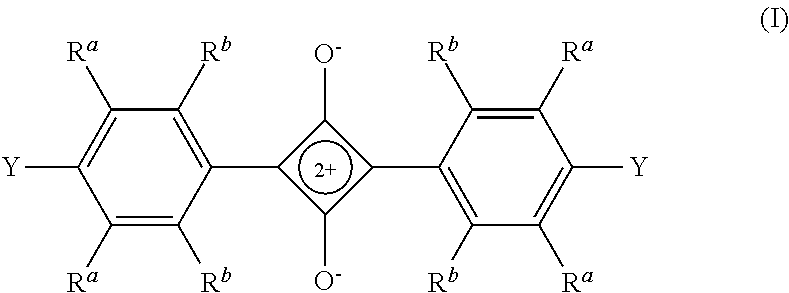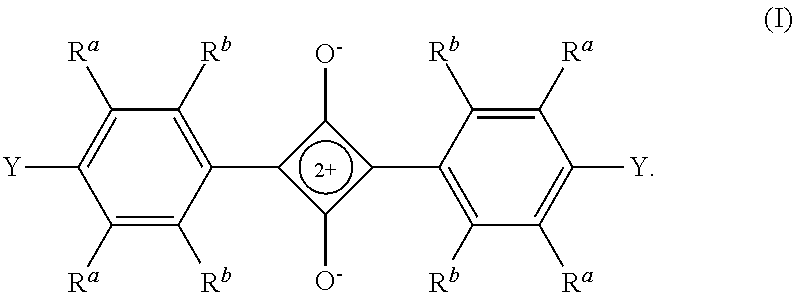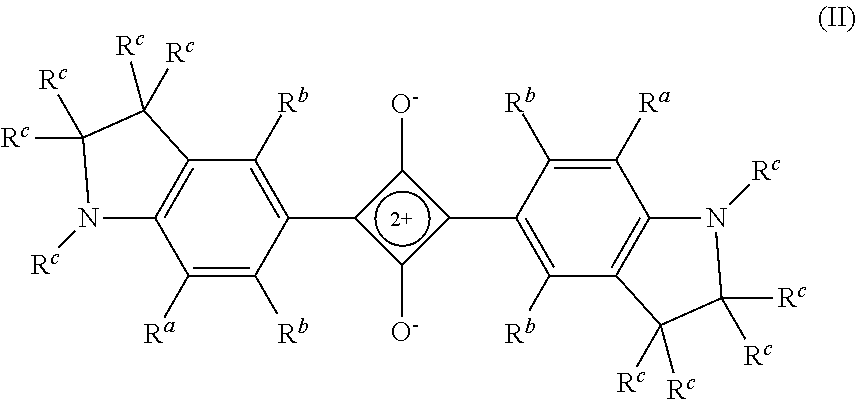Near-infrared cut filter and device including near-infrared cut filter
a near-infrared and cut filter technology, applied in the field can solve the problems of insufficient near-infrared absorbing capacity of near-infrared cut filters according to patent document 1, not only requires a high production cost, and the use of inorganic materials as substrates has limitations in adapting to the recent reduction in size and thickness of solid-state imaging devices, etc., to achieve the effect of small dependence, high transmittance and wide viewing angl
- Summary
- Abstract
- Description
- Claims
- Application Information
AI Technical Summary
Benefits of technology
Problems solved by technology
Method used
Image
Examples
synthesis example 1
[0249]100 parts of 8-methyl-8-methoxycarbonyl tetracyclo[4.4.0.12,5.17,10]dodeca-3-ene represented by the following Formula (a) (hereinafter, also referred to as “DNM”), 18 parts of 1-hexene (molecular weight modifier) and 300 parts of toluene (solvent for ring-opening polymerization reaction) were loaded to a reaction vessel whose atmosphere had been replaced with nitrogen and this solution was heated to 80° C. Then, to the solution in the reaction vessel, as polymerization catalysts, 0.2 parts of a toluene solution of triethyl aluminum (0.6 mol / L) and 0.9 parts of a toluene solution of methanol-modified tungsten hexachloride (concentration: 0.025 mol / L) were added and the resulting solution was heated with stirring at 80° C. for 3 hours to perform a ring-opening polymerization reaction, thereby obtaining a ring-opened polymer solution. The polymerization conversion rate in this polymerization reaction was 97%.
[0250]Next, 1,000 parts of the thus obtained ring-opened polymer solutio...
synthesis example 2
[0252]To a 3-L four-necked flask, 35.12 g (0.253 mol) of 2,6-difluorobenzonitrile, 125.65 g (0.250 mol) of 9,9-bis(3-phenyl-4-hydroxyphenyl)fluorene, 41.46 g (0.300 mol) of potassium carbonate, 443 g of N,N-dimethylacetamide (hereinafter, also referred to as “DMAc”) and 111 g of toluene were added. Subsequently, the four-necked flask was fitted with a thermometer, a stirrer, a nitrogen-introducing tube-equipped three-way stopcock, a Dean-Stark tube and a cooling tube.
[0253]Then, after replacing the atmosphere in the flask with nitrogen, the thus obtained solution was allowed to react at 140° C. for 3 hours and generated water was removed from the Dean-Stark tube as needed. Once water became no longer generated, the temperature was slowly raised to 160° C. and the solution was allowed to react at this temperature for 6 hours.
[0254]After cooling the solution to room temperature (25° C.), generated salt was removed using a filter paper. The filtrate was then added to methanol for repre...
synthesis example 3
[0256]A resin C was obtained in the same manner as in Synthesis Example 2, except that 87.60 g (0.250 mol) of 9,9-bis(4-hydroxyphenyl)fluorene was used in place of 125.65 g (0.250 mol) of 9,9-bis(3-phenyl-4-hydroxyphenyl)fluorene. The thus obtained resin C had a number-average molecular weight (Mn) of 75,000, a weight-average molecular weight (Mw) of 188,000 and a glass transition temperature (Tg) of 285° C.
PUM
| Property | Measurement | Unit |
|---|---|---|
| transmittance | aaaaa | aaaaa |
| wavelength range | aaaaa | aaaaa |
| transmittance | aaaaa | aaaaa |
Abstract
Description
Claims
Application Information
 Login to View More
Login to View More - R&D
- Intellectual Property
- Life Sciences
- Materials
- Tech Scout
- Unparalleled Data Quality
- Higher Quality Content
- 60% Fewer Hallucinations
Browse by: Latest US Patents, China's latest patents, Technical Efficacy Thesaurus, Application Domain, Technology Topic, Popular Technical Reports.
© 2025 PatSnap. All rights reserved.Legal|Privacy policy|Modern Slavery Act Transparency Statement|Sitemap|About US| Contact US: help@patsnap.com



